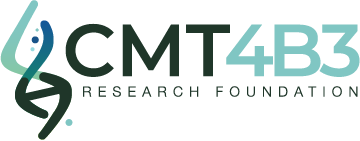
RESEARCH OVERVIEW
The CMT4B3 Research Foundation is the only Foundation working towards a treatment or a cure for this life threatening disease.
We are dedicated to pioneering approaches to scientific exploration that are faster, less expensive and more collaborative. Our advances aren’t just bringing us closer to a cure for CMT4B3, they are being used to discover and treat countless other diseases. In this way, our work doesn’t just help the few — it impacts the lives of many children suffering from rare diseases.
GENE REPLACEMENT THERAPY
Sometimes the whole or part of a gene is defective or missing from birth, or a gene can change or mutate during adult life. Any of these variations can disrupt how proteins are made, which can contribute to health problems or diseases. In gene therapy, scientists can do one of several things depending on the problem that is present. They can replace a gene that causes a medical problem with one that doesn’t, add genes to help the body to fight or treat disease, or turn off genes that are causing problems. In order to insert new genes directly into cells, scientists use a vehicle called a “vector” which is genetically engineered to deliver the gene. Viruses, for example, have a natural ability to deliver genetic material into cells, and therefore, can be used as vectors. Before a virus can be used to carry therapeutic genes into human cells it is modified to remove its ability to cause an infectious disease. Gene therapy can be used to modify cells inside the body. The vector containing the desired gene is introduced into these cells, where they continue to multiply and eventually produce the desired effect.
DRUG REPURPOSING
Drug repurposing is an expeditious way to find an immediate treatment for CMT4B3 patients that could slow the progression of the disease and buy time, while researchers investigate and test genetic pathways to a cure. This process includes testing already existing drugs on a cellular model of CMT4B3. Since these drugs are already developed there is detailed information available on their pharmacology, formulation and potential toxicity. Because repurposing builds upon previous research and development efforts, new candidate therapies could be ready for clinical trials quickly, speeding up their review by the Food and Drug Administration (FDA). Hunter’s CMT4B3 Research Foundation will be working with researchers to identify and test existing drugs that may help slow the progression of the disease.
MODELS OF THE DISEASE
Mice are the most commonly used animal models for studying human disease, and for many good reasons: Mice are biologically very similar to humans and have many of the same diseases, for the same genetic reasons. Mice can be genetically manipulated to mimic virtually any human disease or condition. The mouse is small, making it an economical choice, and it also breeds very well. Scientists have amassed tremendous knowledge about mouse physiology, anatomy, and its genes, stemming from more than 100 years of working with them. The foundation will also be developing other models of the disease including cellular, zebrafish and tadpole models.

